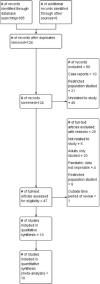Prevalence, Etiology, and Fatality Rates of Childhood Heart Failure in Nigeria: A Systematic Review and Meta-analysis
- PMID: 36704492
- PMCID: PMC9832908
Prevalence, Etiology, and Fatality Rates of Childhood Heart Failure in Nigeria: A Systematic Review and Meta-analysis
Abstract
Objectives: The objectives of the study were to describe the burden, etiology, and fatality rates of heart failure in Nigerian children.
Methods: We searched PubMed database, Google scholar, TRIP database, EMBASE, African Index Medicus, and reference lists of selected articles for studies on burden, etiology, and fatality rates of heart failure in children in Nigeria published from 1977 to 2016. Two researchers reviewed the papers independently. Ten studies were selected that included 14,921 children and 1353 with heart failure.
Results: The overall prevalence of heart failure using all the studies reviewed was 8.3% (95% CI: 4.9-12.6). The prevalence was 13.4% (95% CI: 10.9-16.3) in studies that excluded neonates and 4.5% (95% CI: 2.8-6.5) in studies that included neonates. The most common causes of heart failure were severe anemia (38.9%, 95% CI: 30.0-49.4), respiratory tract infections (32.4%, 95% CI: 25.5-39.7), congenital heart disease (8.4%, 95% CI: 6.8-10.2), and sepsis (7.6%, 95% CI: 3.0-14.0). The overall fatality rate was 16.0% (95% CI: 9.0 - 24.6) and was higher in studies that include neonates.
Conclusion: Heart failure is common in children hospitalized in Nigeria. Its etiology is largely from non-cardiac conditions associated with severe hypoxia and mortality rates are high in children in Nigeria.
Keywords: Etiology; burden; fatality rates; heart failure.
Copyright: © International Journal of Health Sciences.
Figures
Similar articles
-
Heart failure in Nigeria: protocol for a systematic review and meta-analysis.Afr Health Sci. 2023 Jun;23(2):530-536. doi: 10.4314/ahs.v23i2.61. Afr Health Sci. 2023. PMID: 38223635 Free PMC article.
-
Prevalence and associated risk factors for noma in Nigerian children: a systematic review and meta-analysis.BMC Oral Health. 2024 Jun 12;24(1):685. doi: 10.1186/s12903-024-04451-y. BMC Oral Health. 2024. PMID: 38867180 Free PMC article.
-
Global Case-Fatality Rates in Pediatric Severe Sepsis and Septic Shock: A Systematic Review and Meta-analysis.JAMA Pediatr. 2019 Apr 1;173(4):352-362. doi: 10.1001/jamapediatrics.2018.4839. JAMA Pediatr. 2019. PMID: 30742207 Free PMC article.
-
Prevalence and trends of adult overweight and obesity in Nigeria - A systematic review and meta-analysis.Niger J Clin Pract. 2023 Jan;26(1):1-15. doi: 10.4103/njcp.njcp_1903_21. Niger J Clin Pract. 2023. PMID: 36751817
-
Congenital hypothyroidism in India: A systematic review and meta-analysis of prevalence, screen positivity rates, and etiology.Lancet Reg Health Southeast Asia. 2022 Jul 14;5:100040. doi: 10.1016/j.lansea.2022.100040. eCollection 2022 Oct. Lancet Reg Health Southeast Asia. 2022. PMID: 37383660 Free PMC article.
Cited by
-
Prevalence and predictors of poor heart failure treatment outcomes in Ethiopia: a systematic review and meta-analysis.Front Cardiovasc Med. 2024 Dec 24;11:1434265. doi: 10.3389/fcvm.2024.1434265. eCollection 2024. Front Cardiovasc Med. 2024. PMID: 39776867 Free PMC article.
-
Epidemiology of paediatric chronic heart failure in Germany-A population-based analysis.ESC Heart Fail. 2024 Dec;11(6):4371-4380. doi: 10.1002/ehf2.15043. Epub 2024 Sep 3. ESC Heart Fail. 2024. PMID: 39225059 Free PMC article.
-
Prevalence and risk factors of mortality among heart failure patients in low resource setting hospitals: a multicenter prospective observational study.Front Cardiovasc Med. 2024 Nov 21;11:1429513. doi: 10.3389/fcvm.2024.1429513. eCollection 2024. Front Cardiovasc Med. 2024. PMID: 39639976 Free PMC article.
References
-
- Bernstein D. Heart failure. In: Kliegman RM, Stanton BF, St-Geme J, Schor N, Behrman RE, editors. Nelson Textbook of Pediatrics. 20th ed. Philadelphia, PA: Elsevier/Saunders; 2016. pp. 2282–8.
-
- Hsu DT, Pearson GD. Heart failure in children:Part I:History, etiology, and pathophysiology. Circ Heart Fail. 2009;2:63–70. - PubMed
-
- Sommers C, Nagel BH, Neudorf U, Schmaltz AA. Congestive heart failure in childhood. An epidemiologic study. Herz. 2005;30:652–62. - PubMed
-
- Adekanmbi AF, Ogunlesi TA, Olowu AO, Fetuga MB. Current trends in the prevalence and aetiology of childhood congestive cardiac failure in Sagamu. J Trop Pediatr. 2007;53:103–6. - PubMed
Publication types
LinkOut - more resources
Full Text Sources



